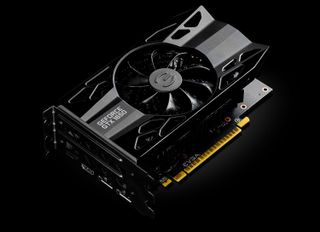For reasons unknown to us, Nvidia's latest GeForce GTX 1650 (full review here) entry-level gaming graphics card is packing the old Volta NVENC (Nvidia encoder) instead of the latest Turing NVENC.

In case you're not familiar with NVENC, it's basically a proprietary encoder that's inherent to Nvidia graphics cards that allow them to execute video encoding workloads. The objective is to offload the video encoding task from the processor to free up resources. The Nvidia NVENC encoder is popular with users of streaming, capturing and encoding programs like Open Broadcaster Software (OBS), Wirecast, Bandicam, HandBrake or Adobe Premiere.
Starting from Kepler and continuing to Turing, each graphics card microarchitecture from Nvidia brought along its own version of the NVENC. It's common assumption that if a graphics card is based on a certain microarchitecture, it would logically feature the respective iteration of that encoder. However, the GeForce GTX 1650 seems to be the black sheep of the GeForce GTX 16-series family.
| Row 0 - Cell 0 | GeForce GTX 1650 | GeForce GTX 1660 | GeForce GTX 1660 Ti |
| Architecture (GPU) | Turing (TU117) | Turing (TU116) | Turing (TU116) |
| CUDA Cores | 896 | 1408 | 1536 |
| Peak FP32 Compute | 3 TFLOPS | 5 TFLOPS | 5.4 TFLOPS |
| Tensor Cores | N/A | N/A | N/A |
| RT Cores | N/A | N/A | N/A |
| Texture Units | 56 | 88 | 96 |
| Base Clock Rate | 1485 MHz | 1530 MHz | 1500 MHz |
| GPU Boost Rate | 1665 MHz | 1785 MHz | 1770 MHz |
| Memory Capacity | 4GB GDDR5 | 6GB GDDR5 | 6GB GDDR6 |
| Memory Clock | 8 Gbps | 8 Gbps | 12 Gbps |
| Memory Bus | 128-bit | 192-bit | 192-bit |
| Memory Bandwidth | 128 GB/s | 192 GB/s | 288 GB/s |
| ROPs | 32 | 48 | 48 |
| L2 Cache | 1MB | 1.5MB | 1.5MB |
| TDP | 75W | 120W | 120W |
| Transistor Count | 4.7 billion | 6.6 billion | 6.6 billion |
| Die Size | 200 mm² | 284 mm² | 284 mm² |
| SLI Support | No | No | No |
| Nvidia Encoder (NVENC) | Volta | Turing | Turing |
According to Nvidia's official specifications, the GeForce GTX 1650 employs the Volta NVENC instead of the Turing NVENC. Nvidia's decision makes no sense at all especially when the GeForce GTX 1660 and GTX 1660 Ti both feature the Turing NVENC. A possible explanation could be that Nvidia is trying to minimize costs to maximize the profits on the GeForce GTX 1650.
Nvidia states that the Volta NVENC's performance is right in the alley of the Pascal NVENC. However, the Turing NVENC is up to 15 percent more efficient than the Volta NVENC and also brings a few improvements to combat artifacting. It isn't a huge deal-breaker if you don't plan on using the NVENC feature on the GeForce GTX 1650. But then again, if you're paying for a next-generation graphics card, you would expect it to come with the latest features.
Stay on the Cutting Edge
Join the experts who read Tom's Hardware for the inside track on enthusiast PC tech news — and have for over 25 years. We'll send breaking news and in-depth reviews of CPUs, GPUs, AI, maker hardware and more straight to your inbox.

Zhiye Liu is a Freelance News Writer at Tom’s Hardware US. Although he loves everything that’s hardware, he has a soft spot for CPUs, GPUs, and RAM.
Most Popular



